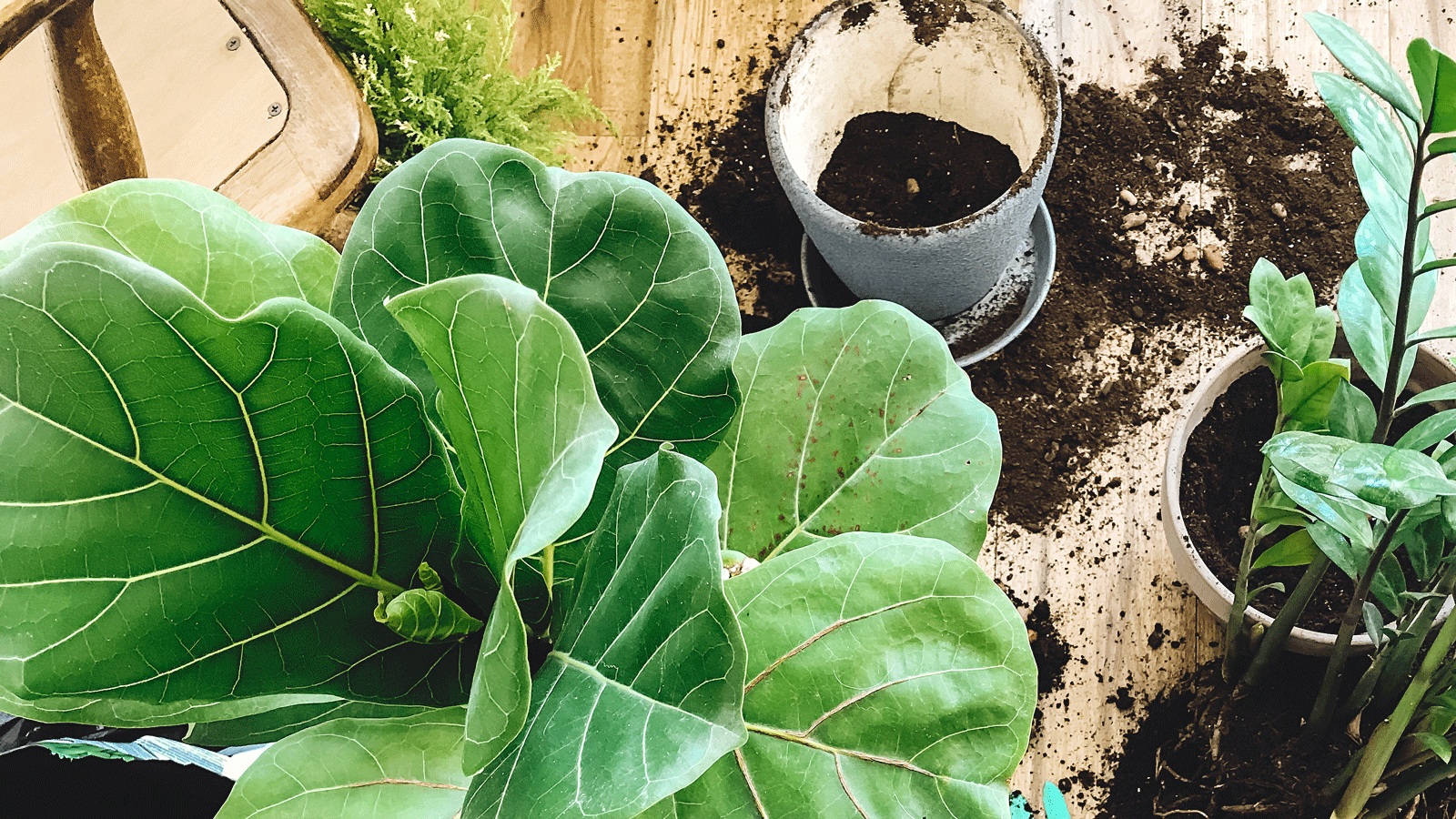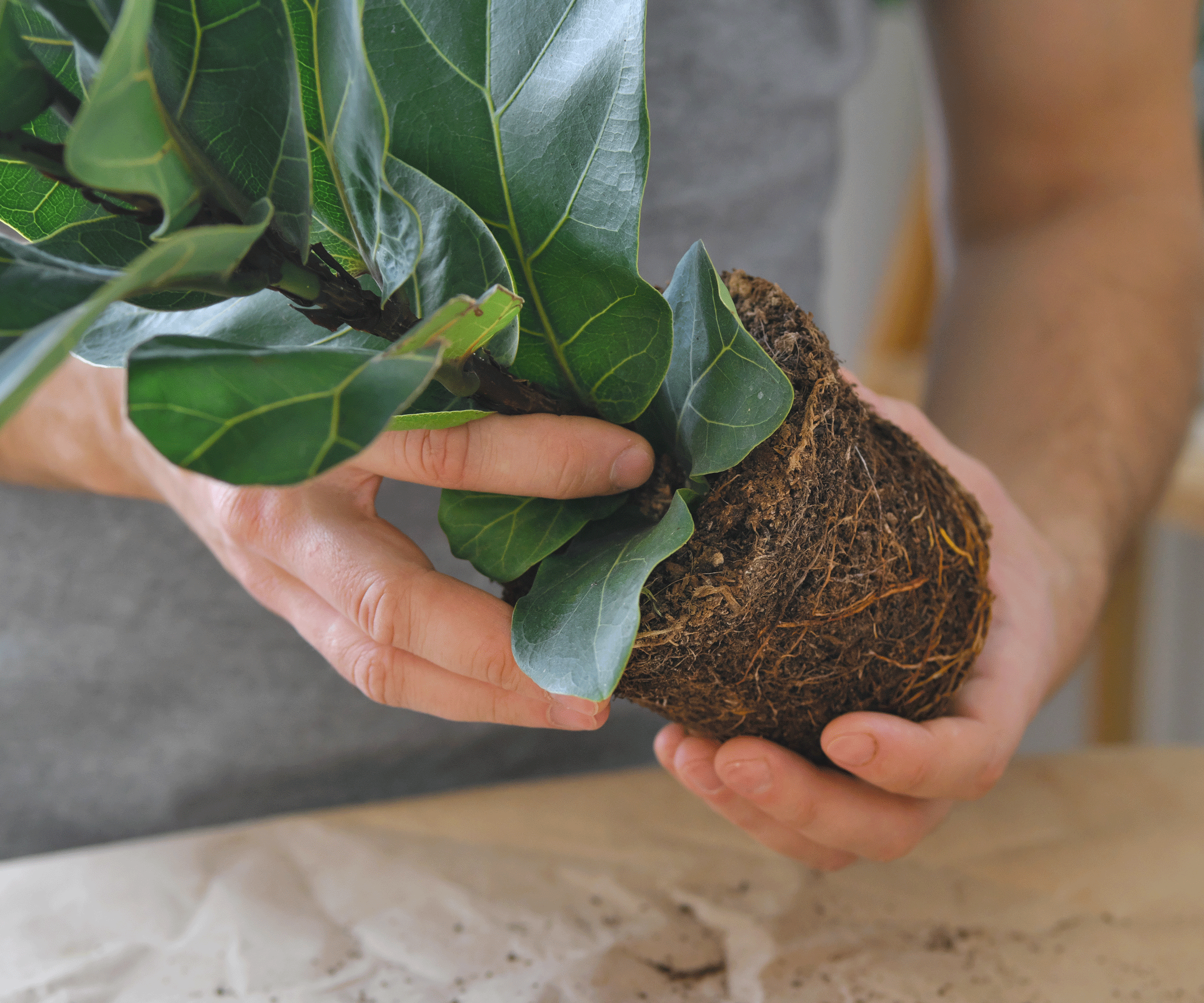My tried-and-tested method for repotting a fiddle leaf fig will help your plant flourish
It's easy to repot a fiddle leaf fig in just five simple steps
- (opens in new tab)
- (opens in new tab)
- (opens in new tab)
- Sign up to our newsletter Newsletter


Repotting a fiddle leaf fig is easy to do and there is no risk to your plant if you follow our expert advice. Known as fast growers, you'll definitely need to find out how to repot one as part of your plant parent skill set. The bigger the plant the bigger the job though, so first be absolutely sure your plant actually needs repotting.
These gorgeous plants don't like any change to their routine so if your fiddle looks healthy and happy it's probably fine to leave it alone for now. I meddled with my best fiddle plant a year or so ago, repotting it unnecessarily as I thought it was 'time'. I chose a normal potting mix that I now realise was too dense and lost lots of leaves in the process as the soil became waterlogged. All is good now as I repotted my plant again with the right soil mix and it's recovered but this is why I'm emphasizing only repot if absolutely necessary.
Finding out how to repot correctly is a crucial part of growing a fiddle leaf fig. So if your fiddle isn't growing as fast as usual, it could be time to think about repotting it, as this is a big clue that your plant could be root bound.

Leave thriving fiddle leaf figs alone unless the roots are tightly wound or breaking out of the plastic pot when you check

Sarah Wilson has been writing about gardens since 2015, covering everything from garden design to houseplant care. She has studied introductory garden and landscape design as well as floristry. A proud houseplant parent, she enjoys tending to her collection of more than 50 indoor plants. Fiddle leaf figs are one of her favorite types and she has learned how to repot her own plants successfully.
When do you need to repot a fiddle leaf fig?
There are several easy-to-spot clues that a fiddle leaf fig plant you’ve had a while needs repotting. As with most indoor plants, the most obvious one is that if you lift up the plant and see roots breaking out of the bottom of the plastic pot it’s definitely time to upgrade your plant with fresh soil and a larger pot.
Another option is to ease the plant out of its plastic pot and if you see lots of roots but very little soil that lets you know your plant needs repotting. Occasionally roots break through the top of the soil too – I know it sounds unlikely but it's happened to me with my eldest fiddle plant, which is now eight years old.
'Another sign that your fiddle needs repotting is constantly dry soil,' says Jennifer Green, botanist at positivebloom.com (opens in new tab). 'Once the root system occupies too much space below the soil surface, there isn’t much soil left, and it can’t hold moisture.'
If your fiddle plant is new don’t assume it will be fine in the pot it came home in either. These plastic pots are designed for nursery growing conditions, which won’t necessarily suit your home environment. Fiddle leaf figs can dry out in just a few days in these pots, so it’s best to get on with repotting as soon as you get them home.
In addition to these scenarios, aim to repot fiddle plants every couple of years. ‘If you notice the root system filling the pot and pushing up against the sides, or if the roots have developed a tightly wound root ball, it’s time to give your fiddle more room in a larger container,’ says plant expert Stephen Webb of Garden’s Whisper (opens in new tab).

Once your fiddle leaf fig plant is repotted you'll see lots of lush and leafy growth
How to repot a fiddle leaf fig in 5 quick steps
Our expert tips on how to repot a fiddle leaf fig show the simple yet effective way to provide the best possible growing environment for your plant to stay healthy.
1. Ease the plant from its old pot

Easy does it - handle the root ball with care
Gently wiggle the root ball free from the plastic pot. You might think it's a good idea to water beforehand so it slides out more easily but avoid doing this as it will make a messy job potentially even messier.
If the plant is stuck and won't budge, cut the old pot with scissors to free it but be very careful not to accidentally damage the roots.
Once the plant is out of the pot check the roots and trim any that are soft or discolored. Loosen and get rid of any old compacted soil that lacks oxygen too.
2. Line up your new pot and soil

Fiddles hate waterlogged roots so it's a good idea to add a draining medium like gravel chips
Increase the new pot size gradually, aiming for one that is 2-3 inches larger every time you repot. Your new container should be both wider and taller than the current one. The roots need space to develop and absorb water and nutrients from the soil. But this becomes difficult if the roots are cramped.
Any pot for a fiddle leaf fig should always have drainage holes. In addition some experts like to add a layer like Smart Gravel, from Amazon (opens in new tab), to keep the root ball dry.
Make sure you have enough fresh potting mix on hand too. The best soil for a fiddle leaf fig is one that is designed to provide air circulation and water retention.
3. Place the plant in the new pot

Make sure the surface of the soil is even and all roots covered
Add a layer of soil to the new pot for your fiddle leaf fig to rest on. Holding the plant upright, fill up the pot with more soil, pressing down as you go so the soil is firm.
Leave a clear inch at the top, so you can water the plant without soil flooding out everywhere. Make sure the surface of the soil is even. Clean your fiddle leaf fig leaves with a soft cloth to remove any soil debris that may be dusting them after the repotting process and leave your plant looking smart in its new pot.
4. Water your repotted fiddle leaf fig
Give your plant a generous watering and let any excess drain out of the bottom by tilting the pot sideways. After a few days, once the soil has fully dried out, water the plant again.
‘It's essential to abstain from watering your recently repotted fiddle leaf fig for a few days to provide the plant with sufficient time to adjust to its new environment,’ says Garden Whisper's Stephen Webb. ‘This period will also give the roots a chance to settle in the soil and start receiving all of the nutrients, minerals, and moisture they were deprived of during the repotting process.’
5. Care for your repotted plant
Keep the plant in bright light after repotting. 'If you can, place the plant in direct sun,’ says Washington DC-based plant expert Vladan Nikolic of mrhouseplant.com (opens in new tab). ‘Bright light will help the plant photosynthesize more, and provide it with the energy needed for the roots to establish well in the new soil.’
Although it's a fairly easy indoor plant to look after, it can take a few weeks for a fiddle leaf fig plant to recover from repotting and to continue growing. Wait around four weeks until your fiddle is settled in its new pot then treat it to a feed of fertilizer. Use either your regular indoor plant fertilizer or alternatively 1tsp of fiddle leaf fig plant food, available from Amazon, (opens in new tab) diluted in two cups of water.
When is the best time of year to repot a fiddle leaf fig?
The best time of year to repot a fiddle leaf fig is spring when it’s warmer as you will shield your plant’s roots from any shock due to cold exposure. It’s easier to do outside anyway so choose a nice warm day. If your plant is too heavy to move lay a sheet of plastic down as repotting fiddles can get messy.
‘If you live in a warm climate and keep your fiddle leaf fig in your backyard, you might need to repot it more frequently as it will grow much faster and hence deplete the soil of nutrients quicker,’ says Mr Houseplant's Vladan Nikolic.

Lifestyle journalist Sarah Wilson has been writing about gardens since 2015. As well as homesandgardens.com she's written for Gardeningetc.com, Livingetc.com, Easy Gardens and Modern Gardens magazines. Her first job on glossy magazines was at Elle, during which time a visit to the legendary La Colombe d'Or in St-Paul-de-Vence led to an interest in all things gardening. Later as lifestyle editor at Country Homes & Interiors magazine the real pull was the run of captivating country gardens that were featured.
-
-
 Robert Pattinson just bought a Spanish Colonial-style home – with an interior designer past
Robert Pattinson just bought a Spanish Colonial-style home – with an interior designer past'The Batman's' Robert Pattinson and Suki Waterhouse purchased the Jeff Lewis-designed Hollywood Hills estate for $5.3 million
By Megan Slack • Published
-
 7 expert-approved methods to remove candle wax from carpet
7 expert-approved methods to remove candle wax from carpetCleaning professionals share their tips on how to remove candle wax from carpet
By Millie Hurst • Published

